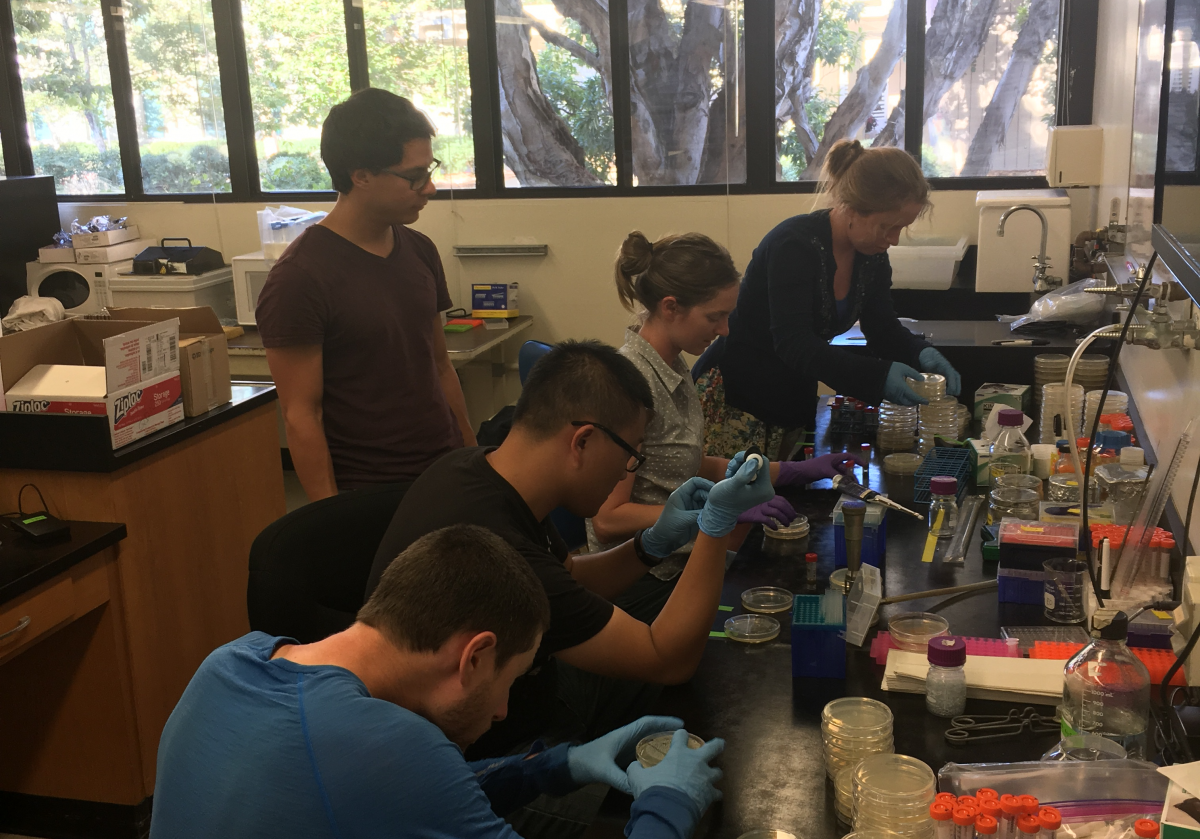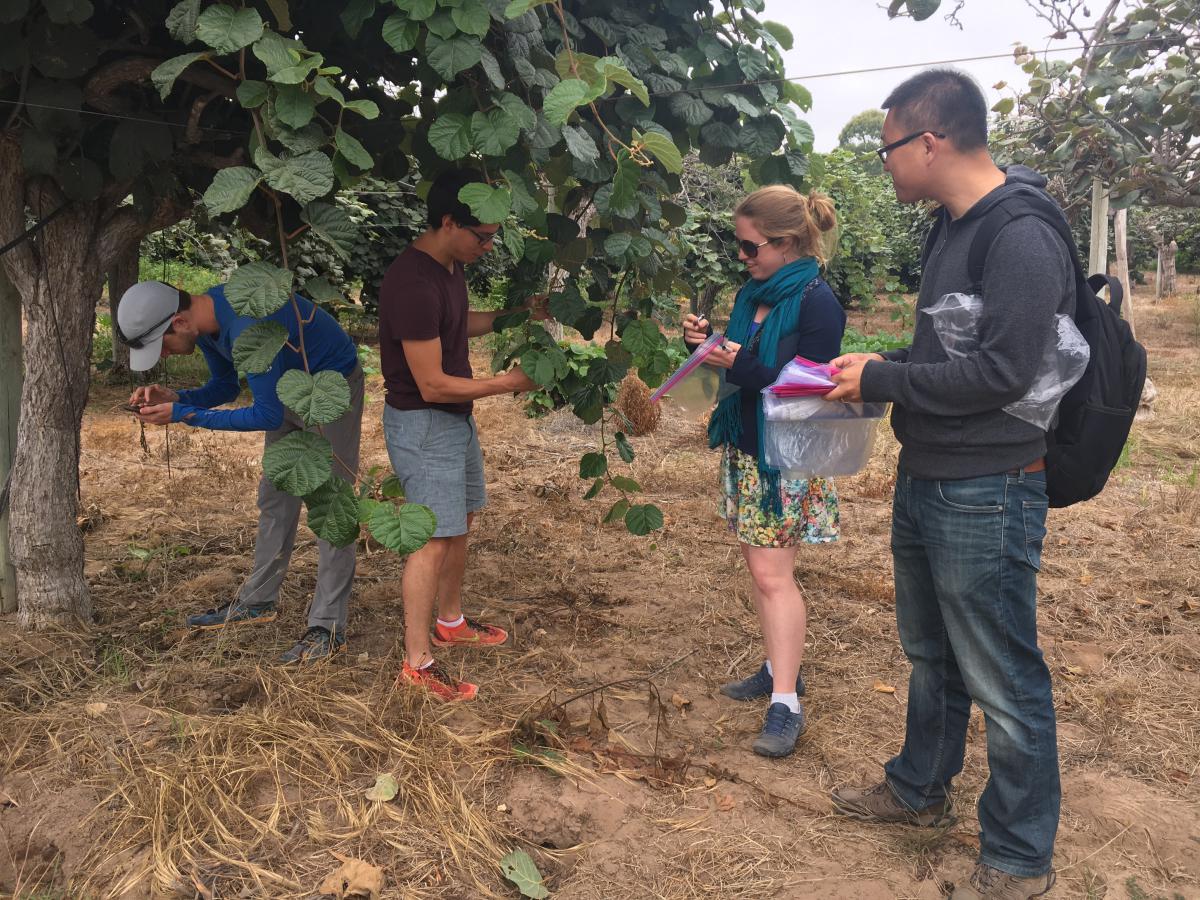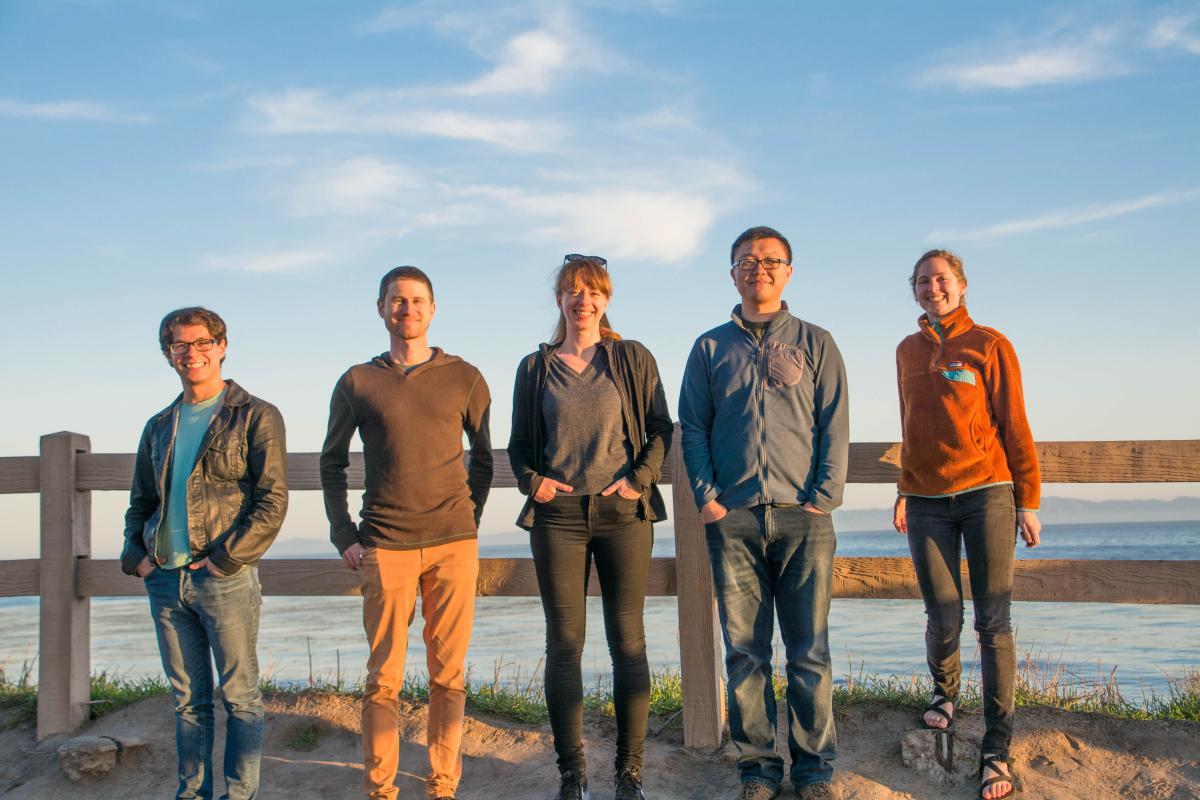 Clockwise from upper left: Regalado, McLaren, Liu, van Raay, and Seward culturing P. graminis during their fall 2018 visit.
Clockwise from upper left: Regalado, McLaren, Liu, van Raay, and Seward culturing P. graminis during their fall 2018 visit.
Each summer, the Santa Barbara Advanced School of Quantitative Biology runs alongside a KITP biology program, distinguishing itself by linking the program’s critical discussion and exploration of important theoretical topics to the lab projects. This school, funded by the Gordon and Betty Moore and Kavli Foundations, affords PhD students and postdocs the opportunity to learn new techniques and explore novel research questions in a dynamic, collaborative atmosphere. The group project we initiated during the Summer 2017 course on Eco-Evolutionary Dynamics in Microbial Communities has become an enduring collaboration.
Our group includes students and postdocs from different disciplines, bringing together experience with experimental approaches, bioinformatic analysis, and theoretical population genetics. Together, we formulated and began to investigate a novel research direction, aiming to understand spatial population structure and patterns of horizontal gene transfer (as opposed to vertical, parent to offspring inheritance) in a bacterial epiphyte. An epiphyte is a non-pathogenic organism that grows on the surface of a plant.
 (L to R): McLaren, Regalado, Seward, and Liu collecting kiwifruit leaves at Mallard Lake Ranch.
(L to R): McLaren, Regalado, Seward, and Liu collecting kiwifruit leaves at Mallard Lake Ranch.
We began the project with an exploratory sampling trip to Mallard Lake Ranch, a kiwifruit farm in Nipomo (California). We wanted to determine whether the non-pathogenic bacterium Pseudomonas syringae, frequently found in association with kiwifruit in New Zealand and East Asia, could be recovered from California orchards. When we sequenced Pseudomonas isolated from both leaf surfaces and within leaf interiors, we were surprised to find that there was no P. syringae among them, and that over half the Mallard Lake Ranch isolates were P. graminis. Comparatively little is known about P. graminis, other than that it exhibits antagonistic activity against a plant pathogen, may serve as a biological control and soil remediation agent, and has been isolated from cloud water. This suggests that P. graminis is a non-pathogenic epiphyte that may be distributed by local or global water cycles.
Our sampling spanned spatial scales from centimeters (within a leaf) to hundreds of meters (across the orchard), providing a unique dataset for population genetic analysis of patterns of growth, dispersal, and recombination in a wild population of bacteria. Our analysis found multiple, coexisting, divergent lineages across the orchard; within a single vine; and in some cases even within a single leaf. We were also able to assess the amount of dispersal within and among vines and the degree of clonality within a leaf.
 (L to R): Regalado, McLaren, McCann, Liu, and van Raay on a break outside Kohn Hall.
(L to R): Regalado, McLaren, McCann, Liu, and van Raay on a break outside Kohn Hall.
Despite the demands of our work at institutions around the world, we continued our conversations and analysis after the course finished. We decided to take advantage of KITP’s Follow-On program, funded by the Kavli and Moore Foundations, which invites program participants back to KITP to continue collaborations initiated on an earlier visit. The Follow-On allowed us to reunite at KITP in spring 2018 for data analysis and discussion. We assembled at KITP again in fall 2018 for a second visit to Mallard Lake Ranch. On this second sampling trip, we specifically targeted P. graminis and obtained a set of isolates that allowed us to assess how spatial diversity had changed over time. This approach recovered P. graminis from every plant sampled, an outstanding outcome given that the field and laboratory work was completed in just two weeks. This work will provide insight into how microbial diversity is structured at multiple spatial scales over time and form the basis of a manuscript that grew out of the rare privileges that KITP provides: freedom and time.
The Kiwifruit Dream Team: Julian Regalado (Max Planck Institute for Developmental Biology), Katrina van Raay (University of Washington), Michael McLaren (North Carolina State) and Xianan Liu (Stony Brook University, SUNY) participated in both the QBio course and one (XL) or both (JR, KvR, MM) Follow-Ons; Elena Colombi (Massey University) participated in the second Follow-On; Wei Ding (Max Planck Institute for Developmental Biology) and Emily Seward (Oxford University) participated during the QBio course.
- Honour McCann, Lecturer at Massey University’s New Zealand Institute for Advanced Study
KITP Newsletter, Spring 2019
